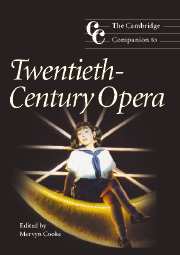Book contents
- Frontmatter
- Part one Legacies
- Part two Trends
- Part three Topographies
- 8 France and the Mediterranean
- 9 Austria and Germany, 1918–1960
- 10 Eastern Europe
- 11 Russian opera: between modernism and romanticism
- 12 American opera: innovation and tradition
- 13 Opera in England: taking the plunge
- Part four Directions
- General index
- Index of operas
11 - Russian opera: between modernism and romanticism
from Part three - Topographies
Published online by Cambridge University Press: 28 September 2011
- Frontmatter
- Part one Legacies
- Part two Trends
- Part three Topographies
- 8 France and the Mediterranean
- 9 Austria and Germany, 1918–1960
- 10 Eastern Europe
- 11 Russian opera: between modernism and romanticism
- 12 American opera: innovation and tradition
- 13 Opera in England: taking the plunge
- Part four Directions
- General index
- Index of operas
Summary
The first stirrings of modernism
The twentieth century began with Rimsky-Korsakov firmly established as the grand old man of Russian opera, with a catalogue of 11 operas to his credit, many of them regularly performed in St Petersburg and Moscow and throughout the provinces as well. His Legend of the Invisible City of Kitezh (completed in 1904 and premiered in 1907) acts as a summation of the nationalist operatic tradition of Glinka and The Five; aside from the characteristically Russian mixture of history and legend, realism and the supernatural, Russian and Oriental, Rimsky-Korsakov alo introduced Wagnerian elements – to the extent that the opera became known as ‘the Russian Parsifal». But in two other operas from these last years of his life, Rimsky-Korsakov was laying the foundation for modernist opera in Russia and beyond. In Kashchei the Immortal (completed and premiered in 1902) and especially The Golden Cockerel (completed in 1907 and premiered in 1909 – after Rimsky-Korsakov's death) the fairy-tale characters are presented as dehumanized, puppet-like figures, while the elements of The Five's nationalist idiom are presented in an exaggerated, parodic manner. Chromatic harmony is pervasive, but this is used by Rimsky-Korsakov in a most un-Wagnerian way, since the music is designed to leave the audience's emotions unengaged.
- Type
- Chapter
- Information
- The Cambridge Companion to Twentieth-Century Opera , pp. 181 - 196Publisher: Cambridge University PressPrint publication year: 2005
- 2
- Cited by



